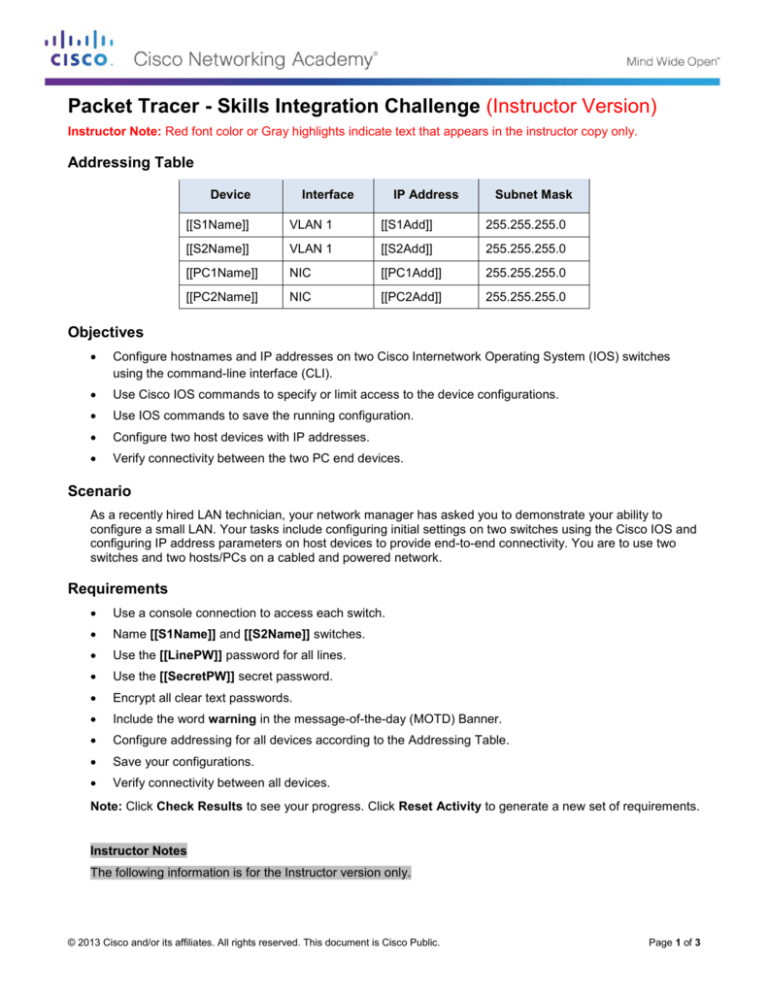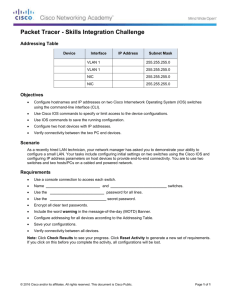
Packet Tracer - Skills Integration Challenge (Instructor Version)
Instructor Note: Red font color or Gray highlights indicate text that appears in the instructor copy only.
Addressing Table
Device
Interface
IP Address
Subnet Mask
[[S1Name]]
VLAN 1
[[S1Add]]
255.255.255.0
[[S2Name]]
VLAN 1
[[S2Add]]
255.255.255.0
[[PC1Name]]
NIC
[[PC1Add]]
255.255.255.0
[[PC2Name]]
NIC
[[PC2Add]]
255.255.255.0
Objectives
Configure hostnames and IP addresses on two Cisco Internetwork Operating System (IOS) switches
using the command-line interface (CLI).
Use Cisco IOS commands to specify or limit access to the device configurations.
Use IOS commands to save the running configuration.
Configure two host devices with IP addresses.
Verify connectivity between the two PC end devices.
Scenario
As a recently hired LAN technician, your network manager has asked you to demonstrate your ability to
configure a small LAN. Your tasks include configuring initial settings on two switches using the Cisco IOS and
configuring IP address parameters on host devices to provide end-to-end connectivity. You are to use two
switches and two hosts/PCs on a cabled and powered network.
Requirements
Use a console connection to access each switch.
Name [[S1Name]] and [[S2Name]] switches.
Use the [[LinePW]] password for all lines.
Use the [[SecretPW]] secret password.
Encrypt all clear text passwords.
Include the word warning in the message-of-the-day (MOTD) Banner.
Configure addressing for all devices according to the Addressing Table.
Save your configurations.
Verify connectivity between all devices.
Note: Click Check Results to see your progress. Click Reset Activity to generate a new set of requirements.
Instructor Notes
The following information is for the Instructor version only.
© 2013 Cisco and/or its affiliates. All rights reserved. This document is Cisco Public.
Page 1 of 3
Packet Tracer - Skills Integration Challenge
This activity uses variables that are randomly generated each time the activity is open or the “Rest Activity”
button is clicked. Although the tables below show device names mapping to specific address schemes, the
names and addresses are not bound together. For example, a student could get the device names shown in
Scenario 1 with the addressing shown in Scenario 2. In addition, one of three versions of the topology will be
presented to the student.
Scenario 1
Device
Interface
Address
Subnet Mask
Class-A
VLAN 1
128.107.20.10
255.255.255.0
Class-B
VLAN1
128.107.20.15
255.255.255.0
Student-1
NIC
128.107.20.25
255.255.255.0
Student-2
NIC
128.107.20.30
255.255.255.0
Scenario 2
Device
Interface
Address
Subnet Mask
Room-145
VLAN 1
172.16.5.35
255.255.255.0
Room-146
VLAN 1
172.16.5.40
255.255.255.0
Manager
NIC
172.16.5.50
255.255.255.0
Reception
NIC
172.16.5.60
255.255.255.0
Scenario 3
Device
Interface
Address
Subnet Mask
ASw-1
VLAN 1
10.10.10.100
255.255.255.0
ASw-2
VLAN 1
10.10.10.150
255.255.255.0
User-01
NIC
10.10.10.4
255.255.255.0
User-02
NIC
10.10.10.5
255.255.255.0
© 2013 Cisco and/or its affiliates. All rights reserved. This document is Cisco Public.
Page 2 of 3
Packet Tracer - Skills Integration Challenge
Topology Isomorphs
© 2013 Cisco and/or its affiliates. All rights reserved. This document is Cisco Public.
Page 3 of 3












